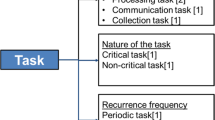Abstract
To minimize the execution time of a sensing task over a multi-hop hierarchical sensor network, we present a coordinated scheduling method following the divisible load scheduling paradigm. The proposed scheduling strategy builds on eliminating transmission collisions and idle gaps between two successive data transmissions. We consider a sensor network consisting of several clusters. In a cluster, after related raw data measured by source nodes are collected at the fusion node, in-network data aggregation is further considered. The scheduling strategies consist of two phases: intra-cluster scheduling and inter-cluster scheduling. Intra-cluster scheduling deals with assigning different fractions of a sensing workload among source nodes in each cluster; inter-cluster scheduling involves the distribution of fused data among all fusion nodes. Closed-form solutions to the problem of task scheduling are derived. Finally, numerical examples are presented to demonstrate the impacts of different system parameters such as the number of sensor nodes, measurement, ommunication, and processing speed, on the finish time and energy consumption.
Similar content being viewed by others
References
Mark Gaynor, Steven L Moulton, Matt Welsh, Ed LaCombe, Austin Rowan, John Wynne. Integrating wireless sensor networks with the grid. IEEE Internet Computing, 2004, 8(4): 32–39.
Carl Hartung, Richard Han, Carl Seielstad, Saxon Holbrook. FireWxNet: A multi-tiered portable wireless system for monitoring weather conditions in wildland fire environments. In Proc. MobiSys 2006, New York, NY, USA, ACM Press, 2006, pp.28–41.
Suman Nath, Jie Liu, Jessica Miller, Feng Zhao, Andre Santanche. SensorMap: A web site for sensors world-wide. In SenSys’06, Boulder, Colorado, USA, 2006, pp.373–374.
Jason Hill, Robert Szewczyk, Alec Woo, Seth Hollar, David Culler, Kristofer Pister. System architecture directions for networked sensors. SIGOPS Oper. Syst. Rev., 2000, 34(5): 93–104.
Feng Zhao, Leonidas Guibas. Wireless Sensor Networks: An Information Processing Approach. Morgan Kaufmann Publishers, 2004.
Chalermek Intanagonwiwat, Ramesh Govindan, Deborah Estrin. Directed diffusion: A scalable and robust communication paradigm for sensor networks. In Proc. MobiCom’00, New York, NY, USA, ACM Press, 2000, pp.56–67.
Cheng Y C, Robertazzi T G. Distributed computation with communication delay [distributed intelligent sensor networks]. IEEE Transactions on Aerospace and Electronic Systems, 1988, 24(6): 700–712.
Jiannong Cao, Alvin T Chan, Yudong Sun, Sajal K Das, Minyi Guo. A taxonomy of application scheduling tools for high performance cluster computing. Cluster Computing, 2006, 9(3): 355–371.
Akyildiz I, Su W, Sankarasubramaniam Y, Cayirci E. A survey on sensor networks. IEEE Communication Magazine, 2002, 40(8): 102–114.
Cerpa A, Elson J, Estrin D, Girod L, Hamilton M, Zhao J. Habitat monitoring: Application driver for wireless communications technology. In Proc. ACM SIGCOMM Workshop on Data Communications in Latin America and the Caribbean, 2001, pp.20–41.
Holger Karl, Andreas Willig. Protocols and Architectures for Wireless Sensor Networks. Wiley, 2006.
Robertazzi T G. Ten reasons to use divisible load theory. Computer, 2003, 36(5): 63–68.
Bharadwaj Veeravalli, Debasish Ghose, Venkataraman Mani, Thomas G Robertazzi. Scheduling Divisible Loads in Parallel and Distributed Systems, Los Almitos: IEEE Computer Society Press, California, 1996.
Yang Yu, Viktor K Prasanna. Energy-balanced task allocation for collaborative processing in wireless sensor networks. Mob. Netw. Appl., 2005, 10(1/2): 115–131.
H Ozgur Sanli, R Poornachandran, H Çam. Collaborative two-level task scheduling for wireless sensor nodes with multiple sensing units. In Proc. IEEE SECON 2005, Santa Clara, USA, 2005, pp.350–361.
Li X, Bharadwaj V, Ko C C. Divisible load scheduling on single-level tree networks with buffer constraints. IEEE Transactions on Aerospace and Electronic Systems, 2000, 36(4): 1298–1308.
Mequanint Moges, Thomas G Robertazzi. Wireless sensor networks: Scheduling for measurement and data reporting. IEEE Transactions on Aerospace and Electronic Systems, 2006, 42(1): 327–340.
Samuel Madden, Michael J Franklin, Joseph M Hellerstein, Wei Hong. TAG: A Tiny AGgregation service for ad-hoc sensor networks. SIGOPS Oper. Syst. Rev., 2002, 36(SI): 131–146.
Hong B, Prasanna V K. Optimizing a class of in-network processing applications in networked sensor systems. In Proc. 2004 IEEE International Conference on Mobile Ad-Hoc and Sensor Systems, Oct. 2004, pp.154–163.
Jia L, Noubir G, Rajaraman R, Sundaram R. GIST: Group-independent spanning tree for data aggregation in dense sensor networks. In Proc. DCOSS’06, San Francisco, 2006, pp.282–304.
Kai-Wei Fan, Sha Liu, Prasun Sinha. Scalable data aggregation for dynamic events in sensor networks. In Proc. SenSys’06, New York, NY, USA, ACM Press, 2006, pp.181–194.
Lige Yu, Lin Yuan, Gang Qu, Anthony Ephremides. Energy-driven detection scheme with guaranteed accuracy. In Proc. IPSN, Nashville, USA, 2006, pp.284–291.
Rajnish Kumar, Matthew Wolenetz, Bikash Agarwalla, Jun-Suk Shin, Phillip Hutto, Arnab Paul, Umakishore Ramachandran. DFuse: A framework for distributed data fusion. In Proc. SenSys’03, New York, NY, USA, ACM Press, 2003, pp.114–125.
Amol Deshpande, Carlos Guestrin, Samuel R Madden, M Hellerstein Joseph, Wei Hong. Model-driven data acquisition in sensor networks. In Proc. the 30th VLDB Conference, Toronto, 2004. http://db.lcs.mit.edu/madden/html/vldb04.pdf.
Lige Yu, Lin Yuan, Gang Qu, Anthony Ephremides. Energy-driven detection scheme with guaranteed accuracy. In Proc. IPSN’06, New York, NY, USA, ACM Press, 2006, pp.284–291.
Li X, Kang H. Autonomic sensor networks: A new paradigm for collaborative information processing. Journal of Autonomic and Trusted Computing, American Scientific Publishers, 2008 (accepted).
Author information
Authors and Affiliations
Corresponding author
Additional information
This work is supported in part by the National Science Foundation of USA under Grant No. CNS-0709329, Hong Kong Polytechnic University via the ICRG Grant No.G-YE57, Hong Kong RGC via the grant of a Research Center for Ubiquitous Computing, and the National Hi-Tech Research and Development 863 Program of China under Grant No. 2006AA01Z231.
Electronic Supplementary Material
Below is the link to the electronic supplementary material.
Rights and permissions
About this article
Cite this article
Li, XL., Cao, JN. Coordinated Workload Scheduling in Hierarchical Sensor Networks for Data Fusion Applications. J. Comput. Sci. Technol. 23, 355–364 (2008). https://doi.org/10.1007/s11390-008-9138-7
Revised:
Published:
Issue Date:
DOI: https://doi.org/10.1007/s11390-008-9138-7




